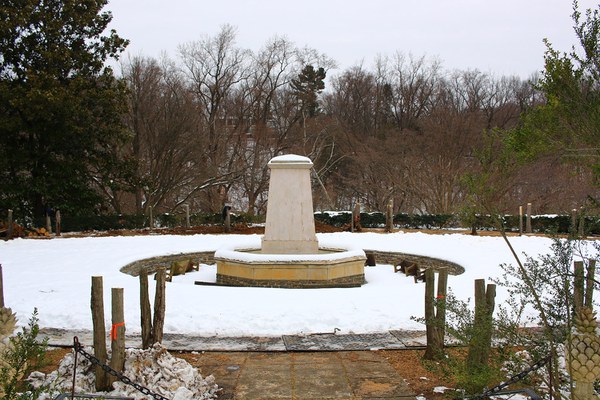The Ellipse has undergone many changes since Beatrix Farrand initially envisioned it as a cohesive part of Box Walk, the sequence of steps leading to the Urn Terrace, lined with Buxus sempervirens ‘Suffruticosa’ (English boxwood). Farrand’s original concept was to create “one of the quietest and most peaceful parts in the garden,” which she achieved by designing a large hedge of Buxus sempervirens (American boxwood) surrounding a greensward, interrupted only by a pool with a jet of water.
When the gardens were transferred to Harvard in 1941, Farrand noted the decline of the boxwood, and wrote in her Plant Book for Dumbarton Oaks that “it is likely that many studies will be necessary before the replacement to the Box hedge around the ellipse can be satisfactorily solved.” She never proposed a fully considered design for its replacement.
The boxwood hedge was removed in 1958, and Alden Hopkins, landscape architect and member of the Garden Advisory Committee at Dumbarton Oaks, implemented a substantial departure from Farrand’s original design, but successfully retained her intent for the Ellipse as a space of reflection and tranquility. Hopkins’s design included the aerial hedge of Carpinus caroliniana (American hornbeam) that is still present today, as well as several fountain elements that have since been removed. The Provençal fountain was relocated to the Ellipse from its former place in the Copse, a small woodland-inspired area, in preparation for the construction of the Phillip Johnson Pre-Columbian Wing of the museum.
Fast-forward 50 years, and the hornbeam hedge is in a state of serious decline due to many factors, including soil health and biology. This winter, after several years of careful planning and preparation, the hornbeam hedge is being replaced with 76 new American hornbeams. These trees are local and have been trained to facilitate shaping them into an aerial hedge, in keeping with Alden Hopkins’s design. The trees are smaller, but with care and time will grow to re-form this iconic garden element.
In addition to replacing the trees, Dumbarton Oaks Gardens and Grounds Department has conducted extensive soil diagnostic work, as this tree replacement project provides the rare opportunity to improve the soil ecology and structure in a way that is not possible with existing trees present. Soil is being removed from the planting beds and improved via the addition of structure-bolstering sand and organic matter to create a customized soil blend that helps prevent compaction and enhances the level of microbial activity, both important components of a healthy soil that will aid in prolonging the lives of the new trees.
Due to the substantial nature of this project, the Ellipse garden is closed through the winter, and reopens in the spring once the planting is complete. While the new Ellipse planting may look minuscule in comparison with the mature trees that once graced its borders, we are confident the new planting will thrive, and in a few years will begin to regain the structure that has shaped this space for the past half century.
Jonathan Kavalier is Director of Gardens and Grounds at Dumbarton Oaks. Photo by Elizabeth Muñoz Huber, Postgraduate Digital Media Fellow.

